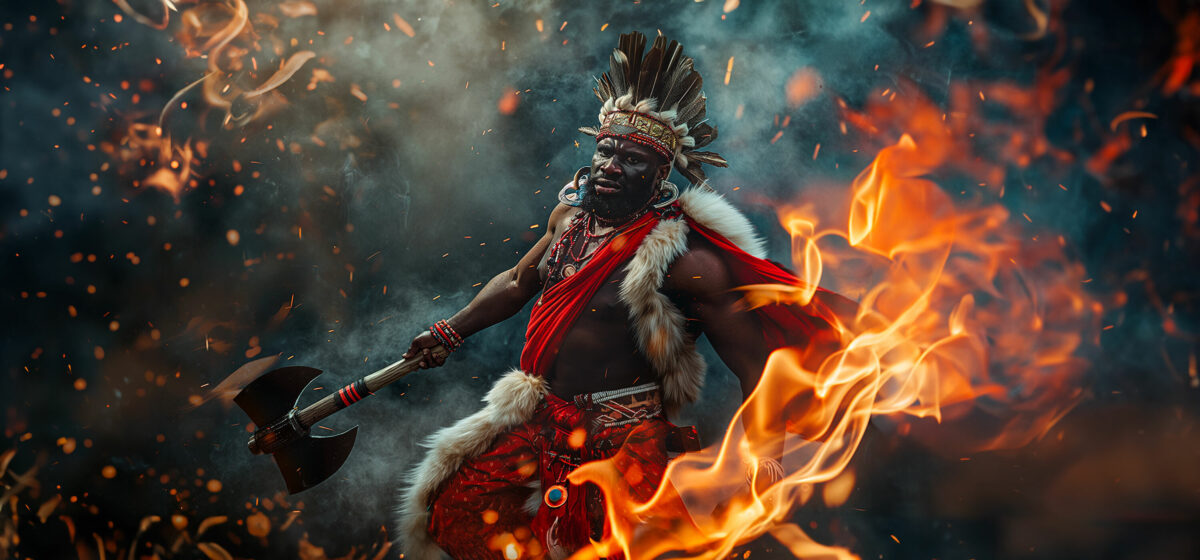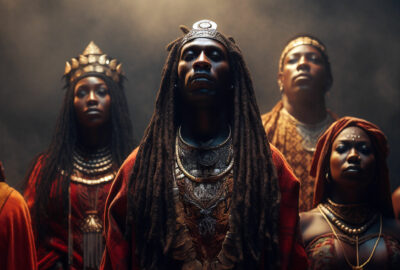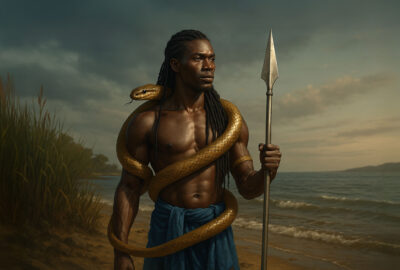
Shango: Orisha of Thunder, Justice, and Divine Strength
Shango, also known as Chango, Sango, or Xango, is one of the most celebrated and powerful Orishas in Yoruba cosmology and throughout the African diaspora. He rules over thunder, lightning, fire, drumming, dancing, justice, and leadership, embodying divine power and moral courage. As one of the revered Seven African Powers, Shango is called upon for strength, protection, and righteous transformation.
In the Yoruba and Santería traditions, Shango’s thunder is more than a storm; it is the sound of divine truth breaking through illusion. His fire purifies what is false, his lightning restores balance, and his dance reminds us that joy can be an act of strength. To understand Shango is to understand that justice is sacred work, and that passion, when aligned with truth, becomes divine power.
The Nature and Power of the Orisha Shango
Shango’s energy is bold, fierce, and life-affirming. He breaks down injustice with the force of a thunderclap and ignites renewal with the fires of transformation. His thunderbolts shatter corruption, yet his presence also brings joy, prosperity, and celebration to those who honor him.
In Yoruba spirituality, Shango represents the divine masculine principle at its highest form: passionate yet disciplined, commanding yet joyful. He teaches that true strength is not destruction for its own sake, but the righteous dismantling of injustice, clearing the path for fairness, balance, and new growth.
Music and dance are his sacred language. In every rhythm of the batá drum and every movement of the dancer’s body, Shango’s spirit awakens. His storms remind us that chaos is never the end; it is the drumbeat of transformation, the beginning of clarity, and the sound of renewal.
How Shango Appears and the Sacred Symbols of His Power
Shango appears to his followers as a vision of divine strength: vibrant, fiery, and majestic. He is dressed in vivid red and white, colors that reflect fire and purity, passion and divine order. In his hand, he carries the Oxê, the double-headed axe that symbolizes his power to create and destroy, to deliver justice and renew life.
Among his sacred emblems are thunderstones, said to fall from the heavens, which devotees use to anchor his energy and invite his protection. The rhythm of drums and the flash of lightning are his language; wherever thunder rolls, his presence is near.
In many Yoruba and Lucumí traditions, Shango’s sacred vessel, the batea, rests upon a carved pilón, forming the throne where his spirit resides. Together they embody the union of heaven and earth: the storm above and the steadfast ground below. Around this vessel, red and white elekes (beads) are often placed to mark devotion and balance his fiery force.
The Lessons of Shango and the Divine Masculine Principle
Shango embodies the divine masculine energy, strength balanced with wisdom, authority tempered with joy. He is a protector, a leader, and a passionate lover of life. His spirit invites not only men but all people to cultivate courage, responsibility, confidence, and purpose. In honoring Shango, we awaken the sacred balance between power and compassion that defines true spiritual maturity.
True power, Shango teaches, is never domination but righteous leadership, the ability to protect without oppressing, to guide with fairness, and to celebrate life with gratitude. His presence reminds us that divine strength always walks hand in hand with integrity and joy.
Through Shango’s example, we learn that justice begins within. When our words and actions align with truth, we become leaders in our own right, protectors of harmony, defenders of fairness, and keepers of the sacred flame. This is the heart of Shango’s teaching: that joy, courage, and responsibility are all expressions of divine strength.
Sacred Stories of Shango
The stories of Shango are more than ancient legends; they are mirrors reflecting the divine lessons of courage, humility, and transformation. In Yoruba and Lucumí tradition, each tale reveals an aspect of his power: the king who became a god, the storm that became renewal, the warrior who learned wisdom through fire. These myths remind us that the Orishas are not distant beings but living teachers, guiding us through the rhythms of life, justice, and rebirth.
The Burning of the Palace
Once, during his reign as king of Oyo, Shango sought to master the forces of thunder and lightning. He was gifted with the knowledge to command fire from the heavens, but with great power came great responsibility. In a moment of anger and pride, Shango unleashed his power recklessly. A bolt of lightning struck his own palace, setting it ablaze.
As the flames devoured the royal halls and the cries of his people filled the air, Shango was overcome with grief and guilt. Believing he had doomed his kingdom, he fled into the wilderness. It was there, far from the throne, that he met his final transformation, not through death, but through ascension. As storms rolled across the sky and thunder rumbled in mourning, Shango rose into the heavens to become an Orisha, forever watching over his people as a force of justice and redemption.
This story reminds us that mistakes can become altars of transformation when we face them with humility and truth.

Shango stands before the burning palace, rising from tragedy to become the Orisha of thunder, justice, and transformation.
The Conflict with Ogun
In Yoruba mythology, Shango’s fiery nature often brought him into conflict with Ogun, the Orisha of iron and labor. While Shango ruled the skies with his lightning and storms, Ogun ruled the earth with his forge and sword.
One day, their rivalry reached a peak. Shango, quick to anger, summoned a mighty storm to flood the fields where Ogun’s people worked. In retaliation, Ogun struck the earth with his tools, forging barriers to block the waters. After days of battling, both Orishas stood exhausted. It was then that they realized that strength without wisdom only leads to ruin. From that day on, they respected each other's domains: Shango commanding the skies, Ogun commanding the earth.
Their story teaches that passion without wisdom burns too hot, and that true power comes when strength and discipline walk together.
The Magical Drums
Long ago, Shango crafted sacred drums, imbued with magic drawn from the heart of storms. These drums could summon rain, call spirits, and stir the very winds to action. Whenever Shango beat the drums, lightning would flash across the sky, and the Orishas would listen.
In Yoruba and Afro-Caribbean practice, Shango’s batá drums are more than instruments; they are voices through which thunder speaks and spirit responds.
One day, enemies threatened Shango’s people. Instead of taking up arms, Shango beat his magical drums. As the rhythms rose, the skies darkened. Thunder answered his call. Lightning struck the ground around the enemy, driving them away without a single sword being drawn. From then on, Shango’s drums became a symbol of righteous power, the ability to command change not just with force, but with spirit and sound.
Shango’s Ascension
After the burning of his palace and his retreat into the wilderness, many believed Shango had died of heartbreak. But one evening, as storms gathered over the hills, the people witnessed a miraculous sight. Thunder shook the ground, and a great lightning bolt split the sky. Out of the storm, Shango’s spirit rose, crowned in fire and clothed in light.
The earth wept with rain, and the heavens roared with drums. It was clear: Shango had not died. He had been reborn into divine power. From that moment forward, he became not just a king of men, but a king of the heavens: a protector, a judge, and a beacon of strength for all who call upon him.
His ascension reminds us that divine power often rises from our deepest trials, that endings are not loss, but transformation.
Shango and His Sacred Wives
The story of Shango’s life would not be complete without the powerful women who shared his heart and destiny. Through them, we see the many faces of love: passion, sweetness, loyalty, and heartbreak, and how even the mightiest warrior is shaped by the forces of devotion and change. The tales of Shango’s wives, Oya, Oshun, and Obba, reveal the balance of forces that shape love, loyalty, and transformation within the Orisha pantheon.
Oya: The Storm Beside Him
Oya, the fierce goddess of winds, storms, and change, was Shango’s equal in fire and fury. Where Shango commanded thunder and lightning, Oya ruled the tempest and whirlwind. Together, Shango and Oya were an unstoppable force, their passions igniting the skies and stirring the very earth beneath them.
Their love was wild and fierce, like the storms they commanded. When they fought, it was said the heavens shook. When they loved, rivers changed course and new lands were born. Oya stood beside Shango not as a passive consort, but as a warrior queen, a partner in battle and in spirit. Through Oya, Shango learned the beauty and the terror of true change, the understanding that destruction clears the way for rebirth.
Oshun: The River that Softens the Fire
If Oya was the storm to Shango’s lightning, Oshun was the river that soothed his flames. The goddess of love, beauty, and fertility, Oshun brought gentleness and grace into Shango’s fiery life. Her laughter was like water over stones; her touch could calm even his fiercest rages.
Oshun taught Shango the power of tenderness. Through her, he learned that strength was not only found in thunder and fire but also in love, sweetness, and nurturing. Their union symbolized the harmony between passion and affection, the blending of heat and flowing water that nourishes life.
Obba: The Loyal Heart and the Power of Sacrifice
Obba, the devoted goddess of home, marriage, and sacrifice, loved Shango with a loyalty so deep that she was willing to give up everything for him. In a tragic story, Obba was tricked into cutting off her own ear in an attempt to win Shango’s favor, only to be rejected and cast aside.
Her sorrow was profound, and she withdrew from the world to heal. But Obba’s story is not one of defeat. It is one of transformation and strength. She became a powerful Orisha in her own right, protecting the sanctity of home and teaching that true love must never come at the cost of one’s dignity.
Through Obba, Shango's tale reminds us that loyalty must be met with honor, and that even in heartbreak, there is the seed of immense power.
Each of these goddesses brings a different lesson to Shango’s story: passion, sweetness, and devotion. You can explore ways to invite their combined energies into your life through Shango, Oya, and Oshun rituals to balance your life.

Saint Barbara is associated with thunder and lightning, which is where the connection to Shango comes in.
Shango and Saint Barbara
The stories of Shango’s power continue beyond Africa into the Americas, where his followers carried his name across oceans and centuries. When African people were torn from their homelands and enslaved in the New World, they carried their Orishas with them in memory, song, and prayer. The colonizers forbade traditional worship, forcing the enslaved to outwardly adopt Christianity. From this struggle, a powerful act of resilience was born: syncretism, the blending of African spiritual traditions with the saints and symbols of Catholicism.
During this era of hidden devotion, Shango found his reflection in Saint Barbara, a Christian martyr whose story resonated deeply with his followers. Saint Barbara was a courageous woman who defied her father's authority and was struck down by a bolt of lightning, a sign of divine justice and retribution. Just as Shango commands thunder and punishes wrongdoing, Saint Barbara became a symbol of sudden and righteous power from the heavens.
In Santería and other Afro-Caribbean traditions, the image of Saint Barbara, often shown holding a sword or standing near a tower, became a sacred veil through which Shango’s worship could continue in secret. Her bright red garments, sometimes painted with flashes of lightning, mirrored the fiery colors that belong to Shango. When the faithful prayed before her image, they were also calling upon the divine king of thunder and fire.
This sacred pairing allowed Shango’s spirit to survive centuries of oppression and remain a source of courage and protection for his people. It also forged an enduring bridge between cultures and faiths. Today, many still honor both Shango and Saint Barbara together, recognizing the shared strength, justice, and resilience they represent.
Through this bond, Shango’s flame was never extinguished. It roared stronger with every storm, offering his children courage, protection, and the timeless reminder that justice always finds a way.
Sacred Symbols, Offerings, and Altars for Shango
Symbols of Shango’s Power
Symbols and sacred tools open the door to Shango’s fiery energy. Each carries part of his essence and helps devotees connect with his presence.
- Colors: Red and white symbolize fire and purity, passion and divine balance.
- Animals: The ram represents strength and virility, the rooster new beginnings, the dog loyalty and protection, and the turtle wisdom and resilience.
- Sacred Nature Symbol: The royal palm tree represents healing, resilience, and divine kingship.
- Numbers: Six and twelve are sacred to Shango, representing harmony, cosmic balance, and divine justice.
- Sacred Tools: The double-headed axe (Oxê) symbolizes his power to create and destroy, while thunderstones and batá drums channel his lightning and rhythm, calling his spirit through sound and vibration.
In many traditions, these symbols are placed on or near Shango’s altar to attract his strength and remind us that power must always serve justice.
Offerings to Shango
Shango delights in offerings that reflect his bold, joyous nature. These gifts honor his energy of celebration and righteousness.
- Red apples, pomegranates, and plantains
- Amala (yam or cornmeal porridge) and okra stew
- Red wine, rum, tobacco, and cigars
- Drumming, dancing, and heartfelt prayer
Place these offerings with reverence, joy, and rhythm. Speak to Shango aloud, expressing gratitude for his protection and courage. When the ritual is complete, dispose of offerings respectfully in nature, thanking him for his blessings:
Mighty Shango, king of thunder, may your fire cleanse all falsehood and your justice guide my path.
Creating a Sacred Space for Shango
Building a home Orisha altar for Shango is an act of devotion and alignment with his divine strength. Begin by covering a table or shelf with a white cloth accented in red.
At the altar’s center, place a batea, the sacred wooden bowl that houses Shango’s spiritual tools. The batea often rests on a pilón, a carved wooden base that represents grounded power and stability. Together they form Shango’s throne, uniting heaven and earth.
Inside or around the batea, include his sacred tools such as miniature double-headed axes, thunderstones, red and white beads (elekes), and a Shango candle dressed with 7 African Powers Oil. Offer fresh fruits, wine, or a small plate of amala to nourish his energy.
When you light the candles, play drumming music or softly tap a rhythm to invite Shango’s spirit. As the flames flicker, imagine lightning clearing your path and strength rising within you.
End your devotion with gratitude, saying:
Shango, king of thunder and fire, thank you for your protection, your justice, and your strength that burns bright within me.
Prayers to Shango
Prayer is how we open our hearts to Shango, calling his strength and wisdom into our lives.
A Shango Prayer for Justice and Protection
Recite this prayer and call upon this dominant Orisha when you are searching for justice and Shango’s powerful protection:
Oh Sovereign and Mysterious spirit Shango who directs the destiny of our lives, watch over me.
Humbly I pray that you light the way for me to obtain, through your secrets and great power as a warrior, fortune, and luck in my job, business, and gambling so that I can take care of my needs and gain a joyful soul and peace of mind.
I kneel before your image, I admire your power, strength, and knowledge, and I ask for your benevolence. In the name of God and the Holy Spirit, protect me from all evil influences and evil thoughts and intentions of my enemies.
There will be no need to retreat because you will be with me and you will help me in all of my needs. Shango, my guide and protector, grant me (say here what you need help with).
In the name of the Father, Son, and The Holy Spirit. Amen.
A Shango Prayer for Love
Recite this prayer and call upon the potent sexual energy of the Orisha Shango when you are looking for love or trying to add fiery passion into your life:
O mighty Shango, God of thunder and fire,
I come to you today with my heart's desire.
I pray for your blessings of love and passion,
To ignite a flame that will never ration.
Grant me the courage to be bold and strong,
To pursue my heart's longing all day long.
May my love be reciprocated and true,
And my heart be filled with joy anew.
O Shango, I call upon your power and might,
To bring me love that will shine bright.
May your blessings of passion and desire,
Set my soul ablaze like a raging fire.
I thank you, Shango, for hearing my prayer,
And for granting me love beyond compare.
With your guidance, I know I will succeed,
And find the love I truly need.

Many worshipers seek Shango's protection and guidance in matters of justice, courage, or protection.
When to Call Upon Shango
Petition Shango whenever you need justice, courage, or protection. He is especially powerful in moments of conflict, legal challenges, or when seeking the strength to overcome obstacles. When you feel called to awaken his energy more directly, explore connecting with Shango for luck and power to strengthen your confidence and draw his blessings into your daily life.
Call upon him through offerings, drumming, and heartfelt prayer when you are ready to transform your life and reclaim your power. Shango’s fire responds to sincerity and courage. Approach him with a clear heart and a just cause, and his thunder will open the way.
The Spirit of Shango’s Children
The Children of Shango carry his fire within them. They are his spiritual descendants, reflecting the courage, rhythm, and passion of the great Orisha of thunder. Charismatic, energetic, and fearless, they light up every space they enter with the force of their presence. They are natural leaders, warriors for justice, protectors of the vulnerable, and champions of truth.
The Children of Shango are not meant for quiet lives. They are drawn to action and to callings where bravery and integrity are needed: the military, law enforcement, activism, politics, entrepreneurship, or any field that demands bold leadership. They stand firm against injustice and never retreat from a worthy fight.
Their temper, like a summer storm, can be fierce and sudden, yet it is rooted in loyalty, honor, and love. They defend those they care for with unshakable devotion and pour their hearts into every cause they believe in. They love deeply, live vibrantly, and lead with fearless hearts.
The path of Shango’s children is one of transformation. Their fire must be tended carefully so it does not consume them, for their power is meant to illuminate, not destroy. When they balance passion with Shango’s wisdom and lead with both strength and joy, they become living thunder: unstoppable forces of truth, courage, and divine justice moving through the world.
Festivals and Celebrations of Shango
Festivals honoring Shango are filled with music, color, and sacred joy. These gatherings celebrate the Orisha through drumming, dance, offerings, and prayer.
One of the most important is the annual Sango Festival in Oyo, Nigeria, held each August to honor Shango’s legacy as both king and Orisha of divine power. Many also honor him on December 4, the feast day of Saint Barbara, who is syncretized with Shango in many Afro-Caribbean traditions.
- Sounds and Dance: Sacred batá drumming and traditional dances call Shango’s spirit to join his people, filling the air with the rhythm of storms.
- Foods and Offerings: Amala, red foods, rum, and other vibrant offerings fuel Shango’s fiery energy and invite his blessings.
- Attire and Symbols: Red and white garments, crowned headpieces, and beaded necklaces express devotion to the king of thunder and fire.
From the Sango Festival in Nigeria to Candomblé ceremonies in Brazil, Shango’s flame continues to burn across continents. His presence moves wherever there is rhythm, courage, and the fight for justice.
FAQs About Working with Shango
How do I know if Shango is calling me?
You may feel drawn to thunder, fire, or the color red, or notice repeated signs of storms and drums in your life. Many also report dreams or flashes of courage and justice during times of struggle. These moments can signal that Shango’s energy is near and ready to guide you.
Can I honor Shango alongside other Orishas?
Yes. Shango often works harmoniously with Oya, Oshun, and Ogun, who balance his power with wisdom, love, and discipline. When working with multiple Orishas, give each their own space and offerings so that their energies remain distinct and respected.
What should I avoid when calling on Shango?
Avoid invoking him in anger or for revenge. Shango stands for righteous justice, not vengeance. Approach him with integrity, courage, and gratitude, asking only for what serves truth and balance.
Is it disrespectful to call upon Shango without initiation?
No. While formal initiation deepens the bond, anyone can pray to Shango for courage, protection, or clarity. The key is respect. Approach him sincerely, research his traditions, and learn from elders or trusted sources when possible.
Is Shango the same as Chango Macho?
No. Shango is an Orisha with deep roots in Yoruba tradition and established ceremonial practices. Chango Macho is a later folk figure who developed through Espiritismo and Caribbean devotional culture. Their names and colors overlap, which leads to confusion, but they belong to different spiritual lineages. If you feel drawn to one or the other, take time to learn their histories and approach each with the respect their path deserves.
What are the signs that Shango has accepted my offering or prayer?
Many experience a rush of warmth, flashes of lightning, a sudden sense of courage, or unexpected resolution of a difficult situation. His acceptance often feels like strength returning to the heart.
Living Shango's Lessons
Shango reminds us that power must always serve justice. He shows that true strength is not found in domination, but in wisdom, integrity, and joy. His spirit urges us to protect the vulnerable, to live with purpose, and to express our passions honorably.
By honoring Shango, we awaken the divine warrior within: the part of ourselves that knows when to act, when to celebrate, and how to transform storms into triumphs. In doing so, we learn that every thunderclap of life carries the promise of renewal and every act of courage echoes the voice of the divine.













